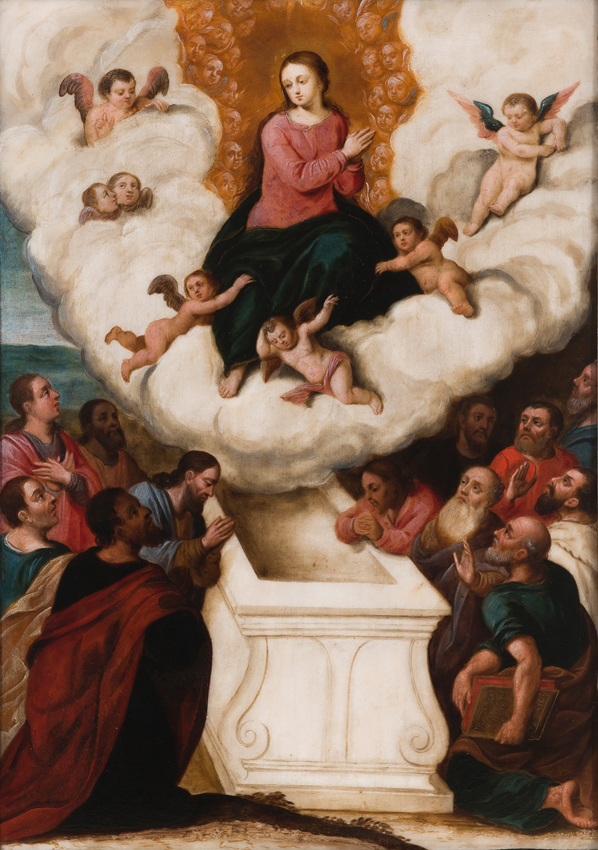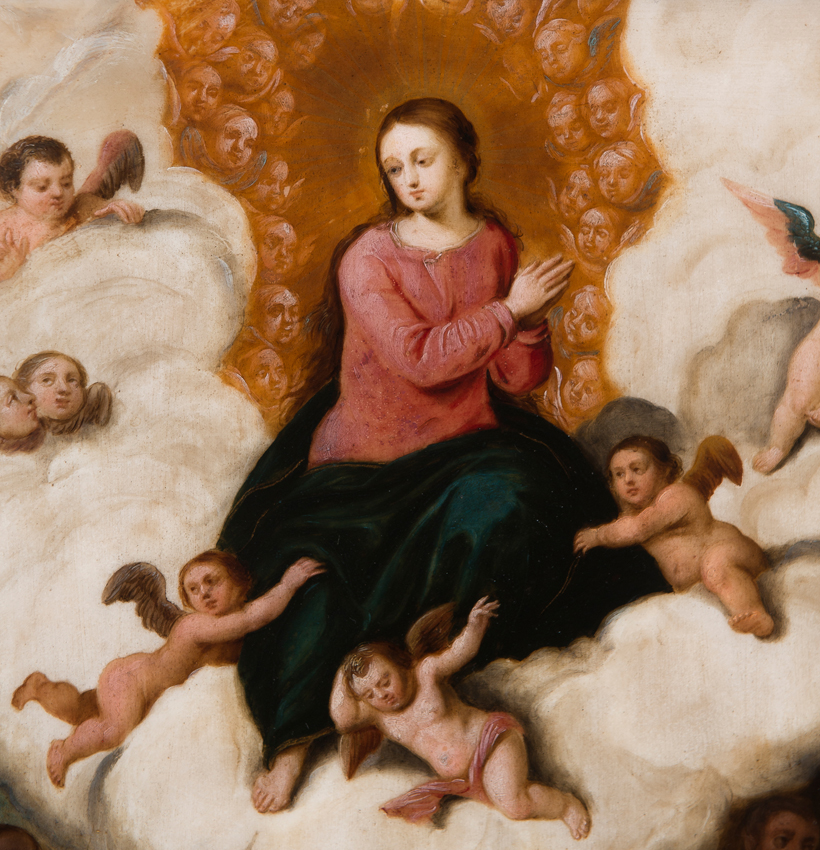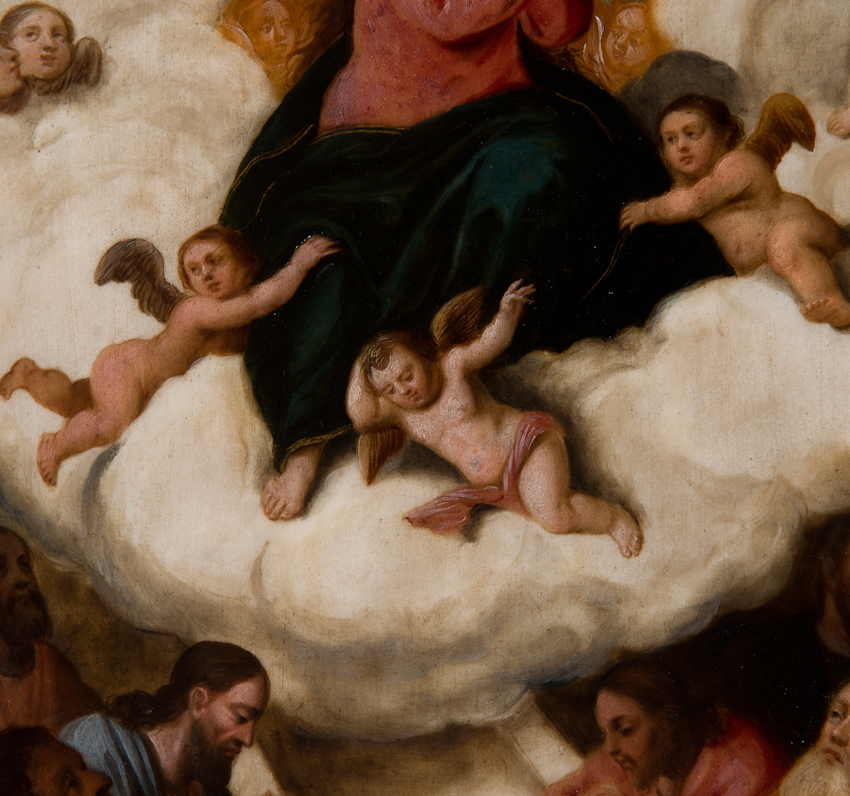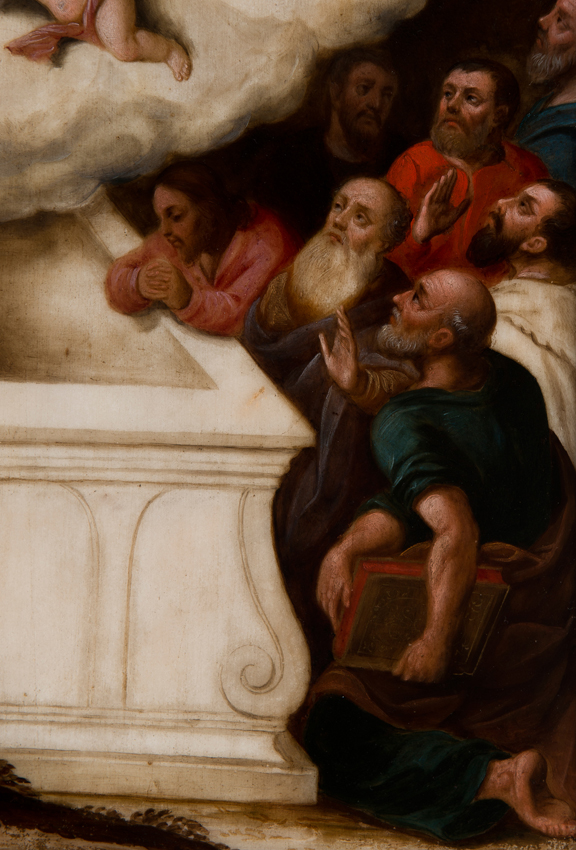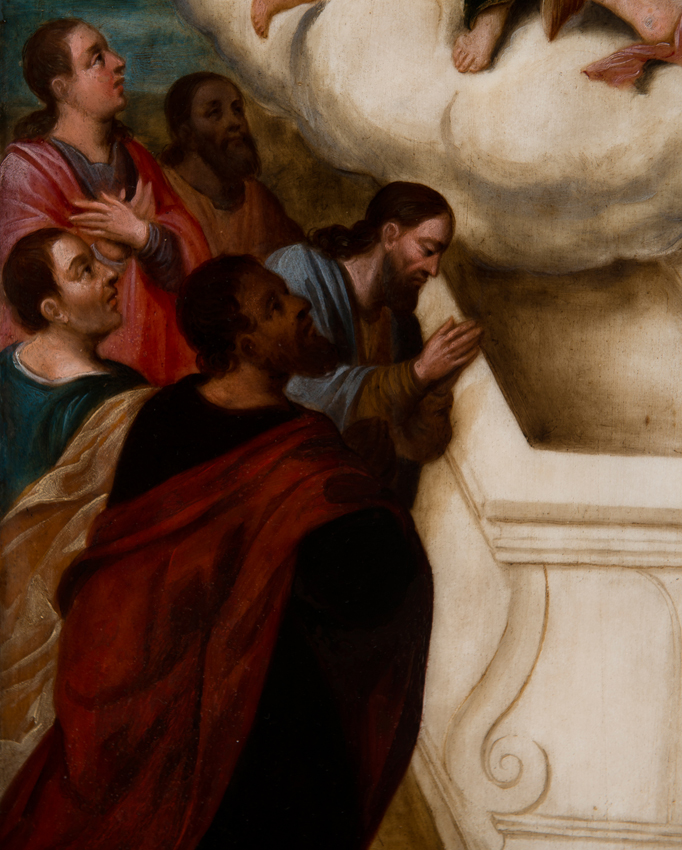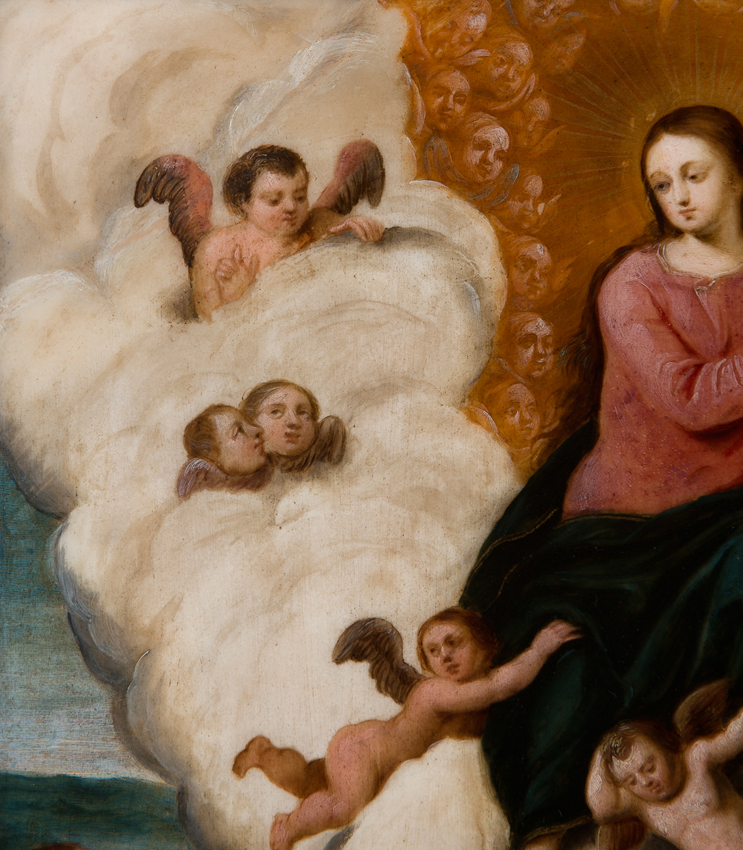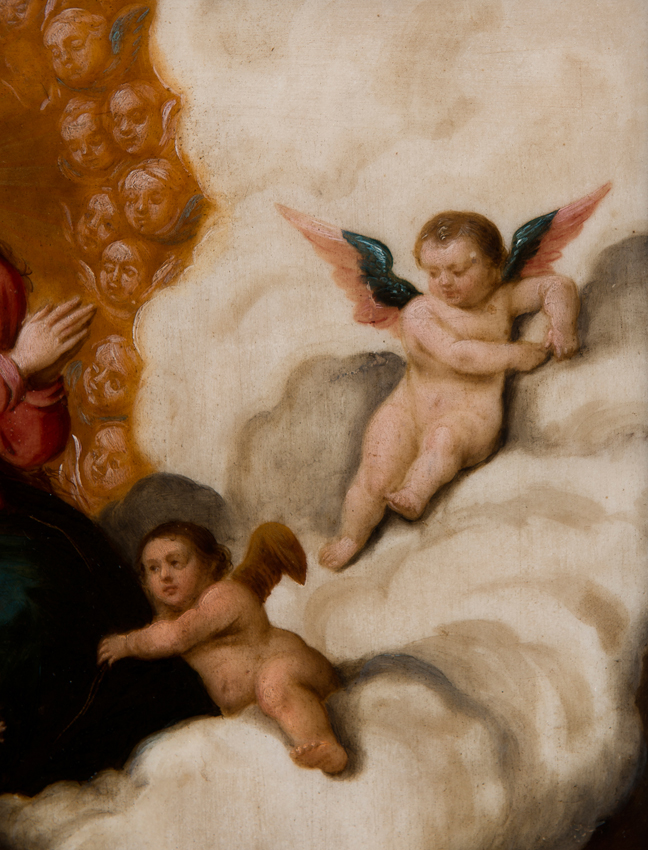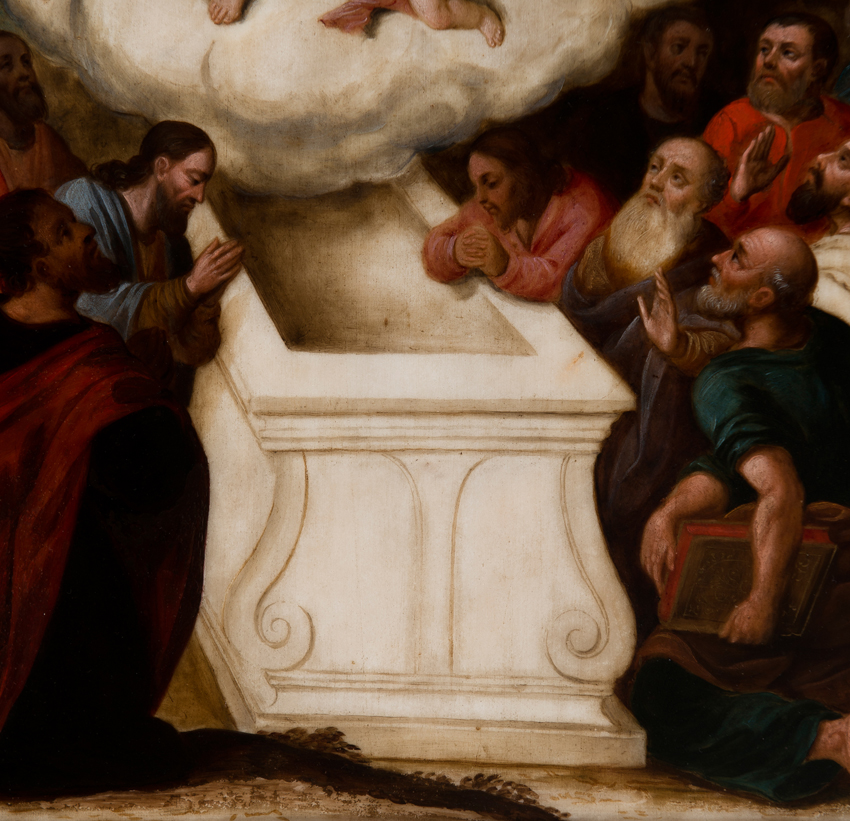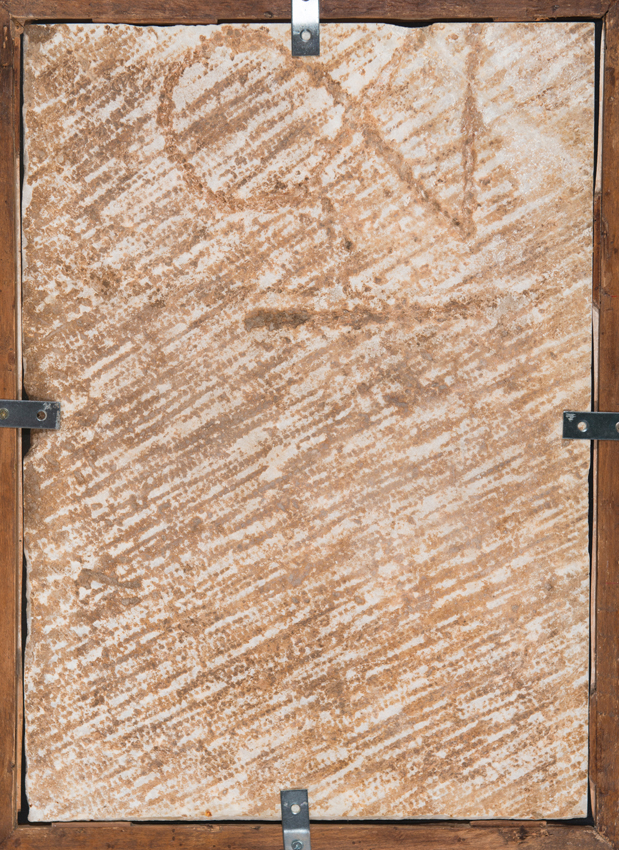42
Lázaro Pardo de Lago (Cuzco, Viceroyalty of Peru, active from 1630 - 1660)
Lazaro Pardo de Lago (Cuzco, Viceroyalty of Peru, active from 1630 - 1660)
"Assumption of Mary, Body and Soul, into Heaven"
Oil on marble
43.5 x 31 cm.
This painting—an exquisite and rare piece due to its unusual marble support—is, in our view, undoubtedly the work of the master Lázaro Pardo de Lago. It may be compared with The Exaltation of the Cross, also by Pardo, held at the Museo Pedro de Osma in Cuzco, Peru. Similarly, the Virgin’s face and the delicately rendered hands can be likened to those in the Immaculate Conception painting from the same museum.
It is also noteworthy that the Church of San Cristóbal in Cuzco houses a signed painting by Lázaro Pardo depicting the Assumption of the Virgin, which closely resembles the painting we have here.
Moreover, there are parallels with an earlier piece by this master, sold as lot 39 in our auction of 5 October 2023. Common features include the depiction of the Virgin, the painter’s palette, golden radiance, and the choir of cherubs among the clouds.
This is a truly rare and precious work, painted on marble—a material rarely used as a painting support. The subject, the Assumption of Mary into Heaven, is one of the most important Marian feasts in the Christian calendar, celebrated on 15 August. Theologically, it is one of the dogmas of faith proclaimed by the Church, along with Mary’s Divine Motherhood, her Immaculate Conception, and Perpetual Virginity. The Assumption was solemnly defined by Pope Pius XII in the Apostolic Constitution Munificentissimus Deus on 1 November 1950, stating that “the Immaculate Mother of God, the ever Virgin Mary, having completed the course of her earthly life, was assumed body and soul into heavenly glory.”
The Cuzco painter—also active as a sculptor and gilder—sought to make the painting everlasting through the use of this enduring medium. The permanence and stability of marble encouraged artists to employ it for the creation of works intended to transcend time. The masterful and delicate brushwork seen here is almost sculptural in effect, with finely modelled faces, garments, clouds, and sepulchral volutes, capturing expressions of rapture and sorrow that mesmerise the viewer.
This painting is likely a study or copy of the same subject painted in 1632 for the Parish of San Cristóbal in Cuzco, based on an engraving after a composition by Peter Paul Rubens, specifically the Assumption of the Virgin engraved by Cornelis Galle.
The artist’s brilliance as a gilder is evident in the golden aura surrounding the Virgin, partially veiled by the cherubs that accompany and venerate her during her celestial ascent.
Surrounding the Virgin, who is enthroned upon clouds, are angels, eleven apostles, and a figure not often seen in Western depictions: Saint Joseph. Though he had died long before the Assumption, the artist includes him according to the tradition of the Eastern Orthodox Church, in which he is said to have been present at Mary’s burial to bid farewell to his wife.
Particularly striking are the faces lifted in ecstatic gaze toward the heavens, seeking the blessing of the ascending Mother of God. Meanwhile, two other figures, filled with sorrow, fix their gaze upon the empty tomb: Joseph, praying mournfully over the grave, and Saint John, “the son who now feels orphaned of his mother.”
As cited by the Real Academia de la Historia (Royal Academy of History), Lázaro Pardo de Lago was a: "Painter, gilder, and Creole or mestizo sculptor, who ranks among the first important masters who worked in the ancient Inca capital. His work was primarily linked to the Franciscan Order, and his more personal style appears to echo early Hispanic naturalism, blending the observation of immediate reality with refined formal stylisation. In 1630, Pardo painted, at the request of the Franciscan monastery of Cuzco, two large canvases depicting the Franciscan martyrs of Japan, which can be considered his masterpieces. Both scenes reveal a painter of exceptional quality, judging by the meticulous precision of his work, the luminous colour, and the strongly characterised heads of some martyrs. Deploying ingenious local expressive resources, Pardo depicted the Asian friars with features similar to those of mestizos or the mixed Hispanic and indigenous people of his time.
Furthermore, Lázaro Pardo was one of the first Cuzco artists who used engravings by Peter Paul Rubens and his school as a starting point for his compositions. An example of this is the Assumption of the Virgin, executed in 1632 by order of the parish of San Cristóbal, based on a homonymous work engraved by Cornelis Galle, following the original design by Rubens.
His workshop must have been one of the largest in Cuzco during his time."
Among the many apprentices who learned the craft or worked in his workshop were his own sons: Juan, Lorenzo, and Salvador Pardo Lago Osorio, who remained active into the 1670s.
His work is preserved in the Church of San Cristóbal and La Recoleta in Cuzco, as well as in the Franciscan Recoleta of Arequipa, amongst other places.
Reference bibliography:
- Real Academia de la Historia. (s.f.). "Lázaro Pardo Lago". https://dbe.rah.es/biografias/70955/lazaro-pardo-lago
Lazaro Pardo de Lago (Cuzco, Viceroyalty of Peru, active from 1630 - 1660)
"Assumption of Mary, Body and Soul, into Heaven"
Oil on marble
43.5 x 31 cm.
This painting—an exquisite and rare piece due to its unusual marble support—is, in our view, undoubtedly the work of the master Lázaro Pardo de Lago. It may be compared with The Exaltation of the Cross, also by Pardo, held at the Museo Pedro de Osma in Cuzco, Peru. Similarly, the Virgin’s face and the delicately rendered hands can be likened to those in the Immaculate Conception painting from the same museum.
It is also noteworthy that the Church of San Cristóbal in Cuzco houses a signed painting by Lázaro Pardo depicting the Assumption of the Virgin, which closely resembles the painting we have here.
Moreover, there are parallels with an earlier piece by this master, sold as lot 39 in our auction of 5 October 2023. Common features include the depiction of the Virgin, the painter’s palette, golden radiance, and the choir of cherubs among the clouds.
This is a truly rare and precious work, painted on marble—a material rarely used as a painting support. The subject, the Assumption of Mary into Heaven, is one of the most important Marian feasts in the Christian calendar, celebrated on 15 August. Theologically, it is one of the dogmas of faith proclaimed by the Church, along with Mary’s Divine Motherhood, her Immaculate Conception, and Perpetual Virginity. The Assumption was solemnly defined by Pope Pius XII in the Apostolic Constitution Munificentissimus Deus on 1 November 1950, stating that “the Immaculate Mother of God, the ever Virgin Mary, having completed the course of her earthly life, was assumed body and soul into heavenly glory.”
The Cuzco painter—also active as a sculptor and gilder—sought to make the painting everlasting through the use of this enduring medium. The permanence and stability of marble encouraged artists to employ it for the creation of works intended to transcend time. The masterful and delicate brushwork seen here is almost sculptural in effect, with finely modelled faces, garments, clouds, and sepulchral volutes, capturing expressions of rapture and sorrow that mesmerise the viewer.
This painting is likely a study or copy of the same subject painted in 1632 for the Parish of San Cristóbal in Cuzco, based on an engraving after a composition by Peter Paul Rubens, specifically the Assumption of the Virgin engraved by Cornelis Galle.
The artist’s brilliance as a gilder is evident in the golden aura surrounding the Virgin, partially veiled by the cherubs that accompany and venerate her during her celestial ascent.
Surrounding the Virgin, who is enthroned upon clouds, are angels, eleven apostles, and a figure not often seen in Western depictions: Saint Joseph. Though he had died long before the Assumption, the artist includes him according to the tradition of the Eastern Orthodox Church, in which he is said to have been present at Mary’s burial to bid farewell to his wife.
Particularly striking are the faces lifted in ecstatic gaze toward the heavens, seeking the blessing of the ascending Mother of God. Meanwhile, two other figures, filled with sorrow, fix their gaze upon the empty tomb: Joseph, praying mournfully over the grave, and Saint John, “the son who now feels orphaned of his mother.”
As cited by the Real Academia de la Historia (Royal Academy of History), Lázaro Pardo de Lago was a: "Painter, gilder, and Creole or mestizo sculptor, who ranks among the first important masters who worked in the ancient Inca capital. His work was primarily linked to the Franciscan Order, and his more personal style appears to echo early Hispanic naturalism, blending the observation of immediate reality with refined formal stylisation. In 1630, Pardo painted, at the request of the Franciscan monastery of Cuzco, two large canvases depicting the Franciscan martyrs of Japan, which can be considered his masterpieces. Both scenes reveal a painter of exceptional quality, judging by the meticulous precision of his work, the luminous colour, and the strongly characterised heads of some martyrs. Deploying ingenious local expressive resources, Pardo depicted the Asian friars with features similar to those of mestizos or the mixed Hispanic and indigenous people of his time.
Furthermore, Lázaro Pardo was one of the first Cuzco artists who used engravings by Peter Paul Rubens and his school as a starting point for his compositions. An example of this is the Assumption of the Virgin, executed in 1632 by order of the parish of San Cristóbal, based on a homonymous work engraved by Cornelis Galle, following the original design by Rubens.
His workshop must have been one of the largest in Cuzco during his time."
Among the many apprentices who learned the craft or worked in his workshop were his own sons: Juan, Lorenzo, and Salvador Pardo Lago Osorio, who remained active into the 1670s.
His work is preserved in the Church of San Cristóbal and La Recoleta in Cuzco, as well as in the Franciscan Recoleta of Arequipa, amongst other places.
Reference bibliography:
- Real Academia de la Historia. (s.f.). "Lázaro Pardo Lago". https://dbe.rah.es/biografias/70955/lazaro-pardo-lago
Millésime 25 · 20th anniversary of La Suite Subastas
Sale Date(s)
Venue Address
General delivery information available from the auctioneer
The purchase price includes the delivery of the lots in the venue of the auction. Transporting to other destinations is at the own risk of the client. The customer must contact "LST", to give the corresponding instructions for such transporting. "LST" is not responsible for the packaging or any accident incurred during transportation.
Important Information
It is important please, that you read our conditions of sale before the auction. If you need us to send them to you by mail, just ask for them.
We would like to remind you that in compliance with Spanish historical heritage laws, lots over 100 years old will need a license, which we will take care of processing for you. This process can take up to a month, as the Ministry of Culture holds only one meeting per month.
The Spanish administration does not charge anything for clients within the European Community, but for non-European Community buyers, the Spanish administration does apply fees. Please contact us for more details on the cost of these fees.
Terms & Conditions
CONDITIONS OF THE AUCTION:
I. REGISTRATION. To bid in the room customers must register at the beginning, filling out a form and picking a number that will identify them during the auction. Customers may be required to register in bank references or other guarantee system and if they do not prove the solvency "LST" will not accept bids and award the auction.
II. WRITTEN BIDS. "LST" will accept written bids, which will be formalized in the form provided by the room until the day before the auction. In such auctions, the room will bid in name of the client until the maximum stated in the offer and always at the lowest possible price. If there are two or more bids for the same amount, the one placed first will have the priority. Written bids received in advance, will have priority on the day of the auction.
III. TELEPHONE BIDS. "LST" will allow telephone bids, if interested people contact "LST" days before the auction providing personal data, ID card and the phone number which will be used by the staff of "LST" to call at the time of the auction. The buyer, within all the legal rights is making an offer for the asking price, when applies for telephone bid. "LST" will not take responsibility for any technical defects beyond its control, which may prevent to contact successfully the bidder during the auction.
IV. AUCTIONEER. The auction will be conducted by an auctioneer, director of the auction will be judge and arbitrator of it with full authority in its development, will award the lots to the highest bidder and is able to settle any controversy concerning lots sale, reject bids, divide lots or group them and remover objects from the room. Will be able to, if it is deemed suitable, not accept bids on the auction. His decision will be unappealable.
V. SALE OF LOTS. The lots are awarded to the highest bidder. Once the auctioneer blows the hammer, the buyer becomes responsible of the lot purchased, exempting "LST" of liability to for any damage and / or accidents that may occur. No refunds of lots.
VI. STARTING PRICE. The amount shown in the catalogue as the starting price for each lot will be, as a rule, the minimum selling price, except for exceptional cases where a reservation may be agreed upon with the seller or it set discretionary by the room.
VII. SCALE OF BIDS. The bids are set according to the following scale:
From 50.-€ to 200.-€…………………………………………..at 10.-€
From 200.-€ to 500.-€…………………………………… …25 in 25.-€
From 500.-€ to 1.000.-€………………………………..…..….50 in 50.-€
From 1.000.-€ to 2.000.-€………………………………..…100 in 100.-€
From 2.000.-€ to 5.000.-€……………………………….….250 in 250.-€
From 5.000.-€ to 10.000.-€…………………………………500 in 500.-€
From 10.000.-€ to 20.000.-€……………………………1.000 in 1.000.-€
From 20.000.-€ to 50.000.-€……………………………2.500 in 2.500.-€
From 50.000.-€ to 100.000.-€…………………………..5.000 in 5.000.-€
From 100.000.-€ to 100.000.-€………………………10.000 in 10.000.-€
From 200.000.-€ to 200.000.-€………………………25.000 in 25.000.-€
From 500.000.-€ to 500.000.-€………………………50.000 in 50.000.-€
VIII. RIGHT OF ADMISION. "LST" reserves the right to admission to the auction room and to reject, at its judgment, any purchase order, from clients whose solvency is not duly proved as well as not to sale auctions.
IX. SALE PRICES. The successful bidder of one or more lots must pay "LST" the final sale price achieves at auction, plus the 24,5 % plus 21% VAT on the commission, at total 29,64 % on Hammer Price.
X. CATALOG DATA. The catalogue data are obtained in order to careful research and advice, however, any responsibility is afforded about its accuracy. The lots will be auctioned in the state in which they are, not accepting any claims in restorations, breakage, damage, imperfections and, even description or numbering mistakes in the catalogue, in case of it, being the burden of the buyers to make sure before the auction that the description matches with their personal opinion about respective lot. The exhibition of the lots is intended to allow a perfect review and study of them.
XI. PAYMENT AND REMOVAL OF LOTS. Payment and removal of the lots will be held no later than five days following the auction. After this period expire without having the buyer removed the lot or lots purchases, it will accrue an expense of custody of 6 euros per day on each lot.
15 days after the auction without having the buyer paid and removes the sold lots, "LST" will inform the seller and there will begin judicial proceeding in order to obtain payment. The delay in payment by the purchaser of his/her sold lots will carry an interest increase at a rate of 1,5% per month.
XII. DELIVERY OF LOTS. The purchase price includes the delivery of the lots in the venue of the auction. Transporting to other destinations is at the own risk of the client. The customer must contact "LST", to give the corresponding instructions for such transporting. "LST" is not responsible for the packaging or any accident incurred during transportation.
XIII. RIGHT OF FIRT REFUSAL AND REPURCHASE. "LST" in order to article 38 of "Ley 16/1985 de 25 Junio del Patrimonio Histórico Español" (BOE. 155 June 29, 1985), will notify in advance to the Ministry of Culture, the content of their catalogues. Concerning the lots subject to the legislation referred to in the preceding paragraph, the Administration may exercise the rights of first refusal and repurchase according to the law. "LST" will watch over the protection of Artistic, Historical and Bibliographical Heritage of Spain. For customers out of European Community, a tax for export is required by the Administration.
XIV. EXPORT LICENSE. In compliance with Spanish historical heritage laws, lots over 100 years old need a export license, which we will take care of processing for you. The Spanish administration does not charge anything for clients within the European Community, but for non-European Community buyers, the Spanish administration does apply fees. Please contact us for more details on the cost of these fees.
XV. VALUE ADDED TAX (I.V.A). This tax will be accrued on commissions of "LST" for buyers, using the rates prevailing on the date of the auction.
XVI. DATA PROTECTION. In order to the "Ley 15/1999 de 13 de Diciembre, de Protección de Datos de Carácter Personal", the client authorize "LST", the inclusion of their data in a customer file, and for the promotion by "LST" of the objects at all times the rights of access, rectification or deletion of personal data by sending the appropriate request to the following address: LA SUITE SUBASTAS, C/ Conde Salvatierra, 8, 08006. Barcelona.
XVII. EXPRESS LEGAL JURISDICTION. These Conditions are governed by and interpreted in accordance with the rules of Spanish law. The mere act of participating in the auction as seller, buyer or bidder, implies acceptance of these Terms and Conditions.
Sales operations are understood to be held at the registered office of "LST", C/ Conde de Salvatierra, 8, 08006. Any dispute shall be taken to the competent courts of Barcelona, expressly waiving any other jurisdiction, in accordance with Article 55 of the "Ley de Enjuiciamiento Civil".






















